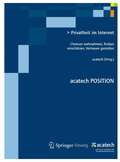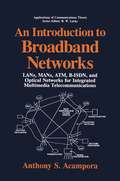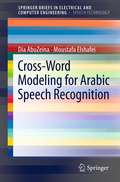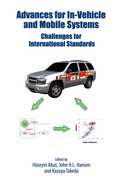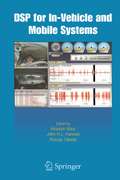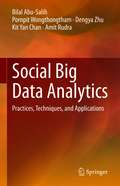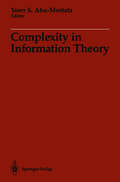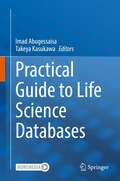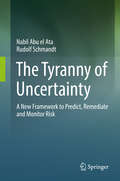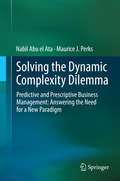- Table View
- List View
Organische Elektronik in Deutschland: Bewertung und Empfehlungen für die Weiterentwicklung (acatech BERICHTET UND EMPFIEHLT)
by AcatechDie organische Elektronik ist eine junge Technologie, die so unterschiedliche Anwendungen wie Leuchtmittel, Photovoltaik, gedruckte Elektronik und Batterien umfasst. Der Einsatz organischer Materialien in elektronischen Bauteilen verspricht Vorteile in ökonomischer, ökologischer wie in gestalterischer Hinsicht. In dem Band wird das Technologiefeld analysiert und der Forschungsbedarf im Hinblick auf Materialien, Prozesstechnik und theoretisches Verständnis herausgearbeitet. Daraus werden Handlungsempfehlungen für Politik und Wirtschaft abgeleitet.
Privatheit im Internet: Chancen wahrnehmen, Risiken einschätzen, Vertrauen gestalten (acatech POSITION)
by AcatechMit seinen digitalen Marktplätzen, Suchmaschinen, sozialen Netzwerken und vielen anderen Diensten kann das Internet zur Verwirklichung grundlegender europäischer Werte beitragen: freie Selbstbestimmung, politische Partizipation und wirtschaftliches Wohlergehen der Menschen. Allerdings bezahlen Nutzerinnen und Nutzer Internet-Dienste häufig mit Daten statt mit Geld, wodurch ihre Privatheit infrage gestellt wird. Angesichts dieser Spannung zeigt acatech, wie eine Internet-Kultur entwickelt werden kann, die es erlaubt, die Chancen des Internets wahrzunehmen und dabei die Privatheit der Menschen schützt. Diese achatech Position enthält konkrete Handlungsempfehlungen, wie Bildung, Wirtschaft, Recht und Technik zu einer solchen Kultur beitragen können.
James Acaster's Guide to Quitting Social Media
by James AcasterThis is a self-help book like no other. Because you are not helping yourself, James Acaster is helping you.In 2019, James quit all forms of social media - covering his phone in tar and driving it to a lock-up in Rhyl, before setting up home in a castle he'd built himself called Castle Anti-Net. But when the withdrawal symptoms hit him, he realised in order to stay clean he'd have to replace everything social media gave him with three-dimensional, real-life activities. Employing the help of a mysterious, wealthy benefactor named Clancy Dellahue, and an ever-growing gang of misfits (aka the Tangfastic Crew), James found ways to replace his online friends (he joined the scouts) and spy on his exes (climbing ropes, zip lines, fake moustache) as well as anonymously bullying strangers, seeing photos of everyone's dogs, getting public figures fired, arguing with everybody about everything, and so much more. His life is amazing and yours could be too if you buy JAMES ACASTER'S GUIDE TO QUITTING SOCIAL MEDIA, BEING THE BEST YOU YOU CAN BE AND SAVING YOURSELF FROM LONELINESS VOL. 1.
Nonsmooth Modeling and Simulation for Switched Circuits (Lecture Notes in Electrical Engineering #69)
by Vincent Acary Olivier Bonnefon Bernard BrogliatoNonsmooth Modeling and Simulation for Switched Circuits concerns the modeling and the numerical simulation of switched circuits with the nonsmooth dynamical systems (NSDS) approach, using piecewise-linear and multivalued models of electronic devices like diodes, transistors, switches. Numerous examples (ranging from introductory academic circuits to various types of power converters) are analyzed and many simulation results obtained with the INRIA open-source SICONOS software package are presented. Comparisons with SPICE and hybrid methods demonstrate the power of the NSDS approach. Nonsmooth Modeling and Simulation for Switched Circuits is intended to researchers and engineers in the field of circuits simulation and design, but may also attract applied mathematicians interested by the numerical analysis for nonsmooth dynamical systems, as well as researchers from Systems and Control.
Computational Intelligence for Semantic Knowledge Management: New Perspectives for Designing and Organizing Information Systems (Studies in Computational Intelligence #837)
by Giovanni Acampora Witold Pedrycz Athanasios V. Vasilakos Autilia VitielloThis book provides a comprehensive overview of computational intelligence methods for semantic knowledge management. Contrary to popular belief, the methods for semantic management of information were created several decades ago, long before the birth of the Internet. In fact, it was back in 1945 when Vannevar Bush introduced the idea for the first protohypertext: the MEMEX (MEMory + indEX) machine. In the years that followed, Bush’s idea influenced the development of early hypertext systems until, in the 1980s, Tim Berners Lee developed the idea of the World Wide Web (WWW) as it is known today. From then on, there was an exponential growth in research and industrial activities related to the semantic management of the information and its exploitation in different application domains, such as healthcare, e-learning and energy management. However, semantics methods are not yet able to address some of the problems that naturally characterize knowledge management, such as the vagueness and uncertainty of information. This book reveals how computational intelligence methodologies, due to their natural inclination to deal with imprecision and partial truth, are opening new positive scenarios for designing innovative semantic knowledge management architectures.
On the Power of Fuzzy Markup Language (Studies in Fuzziness and Soft Computing)
by Giovanni Acampora Vincenzo Loia Chang-Shing Lee Mei-Hui WangOne of the most successful methodology that arose from the worldwide diffusion of Fuzzy Logic is Fuzzy Control. After the first attempts dated in the seventies, this methodology has been widely exploited for controlling many industrial components and systems. At the same time, and very independently from Fuzzy Logic or Fuzzy Control, the birth of the Web has impacted upon almost all aspects of computing discipline. Evolution of Web, Web2.0 and Web 3.0 has been making scenarios of ubiquitous computing much more feasible; consequently information technology has been thoroughly integrated into everyday objects and activities.What happens when Fuzzy Logic meets Web technology? Interesting results might come out, as you will discover in this book. Fuzzy Mark-up Language is a son of this synergistic view, where some technological issues of Web are re-interpreted taking into account the transparent notion of Fuzzy Control, as discussed here. The concept of a Fuzzy Control that is conceived and modeled in terms of a native web wisdom represents another step towards the last picture of Pervasive Web Intelligence.
An Introduction to Broadband Networks: LANs, MANs, ATM, B-ISDN, and Optical Networks for Integrated Multimedia Telecommunications (Applications of Communications Theory)
by Anthony S. AcamporaThis is an elementary textbook on an advanced topic: broadband telecommunica tion networks. I must declare at the outset that this book is not primarily intended for an audience of telecommunication specialists who are weIl versed in the concepts, system architectures, and underlying technologies of high-speed, multi media, bandwidth-on-demand, packet-switching networks, although the techni caIly sophisticated telecommunication practitioner may wish to use it as a refer ence. Nor is this book intended to be an advanced textbook on the subject of broadband networks. Rather, this book is primarily intended for those eager to leam more about this exciting fron tier in the field of telecommunications, an audience that includes systems designers, hardware and software engineers, en gineering students, R&D managers, and market planners who seek an understand ing of local-, metropolitan-, and wide-area broadband networks for integrating voice, data, image, and video. Its primary audience also includes researchers and engineers from other disciplines or other branches of telecommunications who anticipate a future involvement in, or who would simply like to leam more about, the field of broadband networks, along with scientific researchers and corporate telecommunication and data communication managers whose increasingly sophis ticated applications would benefit from (and drive the need for) broadband net works. Advanced topics are certainly not ignored (in fact, a plausible argument could be mounted that aIl of the material is advanced, given the infancy of the topic).
Cross-Word Modeling for Arabic Speech Recognition (SpringerBriefs in Speech Technology)
by Dia AbuZeina Moustafa ElshafeiCross-Word Modeling for Arabic Speech Recognition utilizes phonological rules in order to model the cross-word problem, a merging of adjacent words in speech caused by continuous speech, to enhance the performance of continuous speech recognition systems. The author aims to provide an understanding of the cross-word problem and how it can be avoided, specifically focusing on Arabic phonology using an HHM-based classifier.
Advances for In-Vehicle and Mobile Systems: Challenges for International Standards
by Huseyin Abut Kazuya Takeda John HansenThis second volume on a popular topic brings together the works of scholars working on the latest techniques, standards, and emerging deployment on "living in the age of wireless communications and smart vehicular systems." The format of this work centers on four themes: driver and driving environment recognition, telecommunication applications, noise reduction, dialogue in vehicles. Will interest researchers and professionals working in signal processing technologies, next generation vehicle design and networks for mobile platforms.
DSP for In-Vehicle and Mobile Systems
by Hüseyin Abut John Hansen Kazuya TakedaDSP for In-Vehicle and Mobile Systems is focused on digital signal processing strategies for improving information access, command and control, and communications for in-vehicle environments. It is expected that the next generation of human-to-vehicle interfaces will incorporate speech, video/image, and wireless communication modalities to provide more comfortable and safer driving ambiance. It is also expected that vehicles will become "smarter" and provide a level of wireless information sharing of resources regarding road, weather, traffic, and other information that drivers may need immediately or request at a later time while driving on the road. The format of this work centers on three themes: in-vehicle corpora, speech recognition/dialog systems with emphasis on car environments, and digital signal processing for mobile platforms involving noise suppression, image/video processing, and alternative communication scenarios that can be employed for in-vehicle applications. DSP for In-Vehicle and Mobile Systems is appropriate for researchers and professionals working in signal processing technologies, next generation vehicle design and networked-communications.
Social Big Data Analytics: Practices, Techniques, and Applications
by Bilal Abu-Salih Pornpit Wongthongtham Dengya Zhu Kit Yan Chan Amit RudraThis book focuses on data and how modern business firms use social data, specifically Online Social Networks (OSNs) incorporated as part of the infrastructure for a number of emerging applications such as personalized recommendation systems, opinion analysis, expertise retrieval, and computational advertising. This book identifies how in such applications, social data offers a plethora of benefits to enhance the decision making process.This book highlights that business intelligence applications are more focused on structured data; however, in order to understand and analyse the social big data, there is a need to aggregate data from various sources and to present it in a plausible format. Big Social Data (BSD) exhibit all the typical properties of big data: wide physical distribution, diversity of formats, non-standard data models, independently-managed and heterogeneous semantics but even further valuable with marketing opportunities.The book provides a review of the current state-of-the-art approaches for big social data analytics as well as to present dissimilar methods to infer value from social data. The book further examines several areas of research that benefits from the propagation of the social data. In particular, the book presents various technical approaches that produce data analytics capable of handling big data features and effective in filtering out unsolicited data and inferring a value. These approaches comprise advanced technical solutions able to capture huge amounts of generated data, scrutinise the collected data to eliminate unwanted data, measure the quality of the inferred data, and transform the amended data for further data analysis. Furthermore, the book presents solutions to derive knowledge and sentiments from BSD and to provide social data classification and prediction. The approaches in this book also incorporate several technologies such as semantic discovery, sentiment analysis, affective computing and machine learning.This book has additional special feature enriched with numerous illustrations such as tables, graphs and charts incorporating advanced visualisation tools in accessible an attractive display.
Reporting Political Islam and Democracy: Al Jazeera and the Politics of Journalism
by Mohammed-Ali Abunajela Nael JebrilFor over a decade, Al Jazeera (Arabic) occupied an unprecedented position among Arab audiences and families. Its attractive and daring news coverage has inspired millions of Arabs, and led other news channels to follow suit by changing their reporting narrative and presentational style. However, in the aftermath of the Arab uprisings in 2011, the close adoption of the Arab uprisings in general, and the Egyptian one in particular, made the channel fall into the eye of the public storm through its extensive 24-hour coverage. This book assesses whether the channel systematically provided a platform for certain ideologies or ignored others, and if and how Al Jazeera's language had shifted after the 2011 Arab uprisings. It also explores the rationale behind adopting particular editorial principles featured in the analyses, and scrutinises the findings within the framework of media, religion and democratisation.
Reporting Political Islam and Democracy: Al Jazeera and the Politics of Journalism
by Mohammed-Ali Abunajela Nael JebrilFor over a decade, Al Jazeera (Arabic) occupied an unprecedented position among Arab audiences and families. Its attractive and daring news coverage has inspired millions of Arabs, and led other news channels to follow suit by changing their reporting narrative and presentational style. However, in the aftermath of the Arab uprisings in 2011, the close adoption of the Arab uprisings in general, and the Egyptian one in particular, made the channel fall into the eye of the public storm through its extensive 24-hour coverage. This book assesses whether the channel systematically provided a platform for certain ideologies or ignored others, and if and how Al Jazeera's language had shifted after the 2011 Arab uprisings. It also explores the rationale behind adopting particular editorial principles featured in the analyses, and scrutinises the findings within the framework of media, religion and democratisation.
Complexity in Information Theory
by Yaser S. Abu-MostafaThe means and ends of information theory and computational complexity have grown significantly closer over the past decade. Common analytic tools, such as combinatorial mathematics and information flow arguments, have been the cornerstone of VLSl complexity and cooperative computation. The basic assumption of limited computing resources is the premise for cryptography, where the distinction is made between available information and accessible information. Numerous other examples of common goals and tools between the two disciplines have shaped a new research category of 'information and complexity theory'. This volume is intended to expose to the research community some of the recent significant topics along this theme. The contributions selected here are all very basic, presently active, fairly well-established, and stimulating for substantial follow-ups. This is not an encyclopedia on the subject, it is concerned only with timely contributions of sufficient coherence and promise. The styles of the six chapters cover a wide spectrum from specific mathematical results to surveys of large areas. It is hoped that the technical content and theme of this volume will help establish this general research area. I would like to thank the authors of the chapters for contributing to this volume. I also would like to thank Ed Posner for his initiative to address this subject systematically, and Andy Fyfe and Ruth Erlanson for proofreading some of the chapters.
Nonlinear H2/H-Infinity Constrained Feedback Control: A Practical Design Approach Using Neural Networks (Advances in Industrial Control)
by Murad Abu-Khalaf Jie Huang Frank L. LewisThis book provides techniques to produce robust, stable and useable solutions to problems of H-infinity and H2 control in high-performance, non-linear systems for the first time. The book is of importance to control designers working in a variety of industrial systems. Case studies are given and the design of nonlinear control systems of the same caliber as those obtained in recent years using linear optimal and bounded-norm designs is explained.
Practical Guide to Life Science Databases
by Imad Abugessaisa Takeya KasukawaThis book provides the latest information of life science databases that center in the life science research and drive the development of the field. It introduces the fundamental principles, rationales and methodologies of creating and updating life science databases. The book brings together expertise and renowned researchers in the field of life science databases and brings their experience and tools at the fingertips of the researcher. The book takes bottom-up approach to explain the structure, content and the usability of life science database. Detailed explanation of the content, structure, query and data retrieval are discussed to provide practical use of life science database and to enable the reader to use database and provided tools in practice. The readers will learn the necessary knowledge about the untapped opportunities available in life science databases and how it could be used so as to advance basic research and applied research findings and transforming them to the benefit of human life.Chapter 2 is available open access under a Creative Commons Attribution 4.0 International License via link.springer.com.
Advances in Analysis and Design of Deep Foundations: Proceedings of the 1st GeoMEast International Congress and Exhibition, Egypt 2017 on Sustainable Civil Infrastructures (Sustainable Civil Infrastructures)
by Murad Abu-Farsakh Khalid Alshibli Anand PuppalaThis volume on “Advances in Analysis and Design of Deep Foundations” contains 22 technical papers which cover various aspects of analysis and design of deep foundations based on full-scale field testing, numerical modeling, and analytical solutions. The technical papers are 8-10 pages long that present the results and findings from research as well as practical-oriented studies on deep foundations that are of interest to civil/geotechnical engineering community. The topics cover a wide spectrum of applications that include evaluation of the axial and lateral capacity of piles, pile group effects, evaluation of the increase in pile capacity with time (or pile setup), influence of excavation on pile capacity, study the behavior of pile raft caisson foundations, evaluate the bearing capacity and settlement of piles from cone penetration tests, etc. This volume is part of the proceedings of the 1st GeoMEast International Congress and Exhibition on Sustainable Civil Infrastructures, Egypt 2017.
Feature Selection and Enhanced Krill Herd Algorithm for Text Document Clustering (Studies in Computational Intelligence #816)
by Laith Mohammad AbualigahThis book puts forward a new method for solving the text document (TD) clustering problem, which is established in two main stages: (i) A new feature selection method based on a particle swarm optimization algorithm with a novel weighting scheme is proposed, as well as a detailed dimension reduction technique, in order to obtain a new subset of more informative features with low-dimensional space. This new subset is subsequently used to improve the performance of the text clustering (TC) algorithm and reduce its computation time. The k-mean clustering algorithm is used to evaluate the effectiveness of the obtained subsets. (ii) Four krill herd algorithms (KHAs), namely, the (a) basic KHA, (b) modified KHA, (c) hybrid KHA, and (d) multi-objective hybrid KHA, are proposed to solve the TC problem; each algorithm represents an incremental improvement on its predecessor. For the evaluation process, seven benchmark text datasets are used with different characterizations and complexities.Text document (TD) clustering is a new trend in text mining in which the TDs are separated into several coherent clusters, where all documents in the same cluster are similar. The findings presented here confirm that the proposed methods and algorithms delivered the best results in comparison with other, similar methods to be found in the literature.
Classification Applications with Deep Learning and Machine Learning Technologies (Studies in Computational Intelligence #1071)
by Laith AbualigahThis book is very beneficial for early researchers/faculty who want to work in deep learning and machine learning for the classification domain. It helps them study, formulate, and design their research goal by aligning the latest technologies studies’ image and data classifications. The early start-up can use it to work with product or prototype design requirement analysis and its design and development.
Nanometer Variation-Tolerant SRAM: Circuits and Statistical Design for Yield
by Mohamed Abu Rahma Mohab AnisVariability is one of the most challenging obstacles for IC design in the nanometer regime. In nanometer technologies, SRAM show an increased sensitivity to process variations due to low-voltage operation requirements, which are aggravated by the strong demand for lower power consumption and cost, while achieving higher performance and density. With the drastic increase in memory densities, lower supply voltages, and higher variations, statistical simulation methodologies become imperative to estimate memory yield and optimize performance and power.This book is an invaluable reference on robust SRAM circuits and statistical design methodologies for researchers and practicing engineers in the field of memory design. It combines state of the art circuit techniques and statistical methodologies to optimize SRAM performance and yield in nanometer technologies. Provides comprehensive review of state-of-the-art, variation-tolerant SRAM circuit techniques; Discusses Impact of device related process variations and how they affect circuit and system performance, from a design point of view;Helps designers optimize memory yield, with practical statistical design methodologies and yield estimation techniques.
The Tyranny of Uncertainty: A New Framework to Predict, Remediate and Monitor Risk
by Nabil Abu el Ata Rudolf SchmandtThe authors offer a revolutionary solution to risk management. It’s the unknown risks that keep leaders awake at night—wondering how to prepare for and steer their organization clear from that which they cannot predict. Businesses, governments and regulatory bodies dedicate endless amounts of time and resources to the task of risk management, but every leader knows that the biggest threats will come from some new chain of events or unexpected surprises—none of which will be predicted using conventional wisdom or current risk management technologies and so management will be caught completely off guard when the next crisis hits. By adopting a scientific approach to risk management, we can escape the limited and historical view of experience and statistical based risk management models to expose dynamic complexity risks and prepare for new and never experienced events.
Solving the Dynamic Complexity Dilemma: Predictive and Prescriptive Business Management: Answering the Need for a New Paradigm
by Nabil Abu el Ata Maurice J. PerksDynamic complexity results from hidden, unknown factors—or more precisely, interactions between factors—that can unexpectedly impact the performance of systems. When the influences of dynamic complexity are not measured and understood, new never-seen-before behaviors can come as unwelcomed surprises, which disrupt the performance of systems. Left alone, processes that were once prized for their efficiency unexpectedly begin to degrade—costs increase, while volumes and quality decline. Evidence of problems may come too late for effective resolution as technology advancements induce rapid change and compress the time available to react to that change. The results of dynamic complexity are always negative and unmanaged dynamic complexity can bring business or global systems to the point of sudden chaos. The 2009 H1N1 pandemic, 2008 Credit Crunch and 2011 Fukushima Daiichi nuclear disaster are global examples of the dangers of undiagnosed dynamic complexity.With increasing frequency executive leaders today are discovering that their business and IT system performance levels are not meeting expectations. In most cases these performance deficiencies are caused by dynamic complexity, which lies hidden like a cancer until the symptoms reveal themselves—often when it is too late to avoid negative impacts on business outcomes. This book examines the growing business problem of dynamic complexity and presents a path to a practical solution. To achieve better predictability, organizations must be able to expose new, dangerous patterns of behavior in time to take corrective actions and know which actions will yield the optimal results. The book authors promote new methods of risk management that use data collection, analytics, machine learning and automation processes to help organizations more accurately predict the future and take strategic actions to improve performance outcomes. The presented means of achieving this goal are based upon the authors’ practical experiences, backed by scientific principles, and results achieved through consulting engagements with over 350 global organizations.
Grundkurs Wirtschaftsinformatik: Eine kompakte und praxisorientierte Einführung
by Dietmar Abts Wilhelm MülderIn diesem Lehrbuch erhalten Sie eine gut verständliche, praxisnahe Darstellung der gesamten Wirtschaftsinformatik. Neben den wichtigsten Hardware-Komponenten werden Software-Entwicklung, Internet, Mobilkommunikation sowie Datenbanken erläutert. Bei den Anwendungssystemen werden ERP-Systeme, Business Intelligence, E-Business, M-Business und Social Media beschrieben. Um Software zu entwickeln bzw. einzuführen, sind Methoden der Wirtschaftsinformatik erforderlich. Hierbei geht es um Projektmanagement, Software-Entwicklung, Geschäftsprozessmodellierung und IT-Sicherheitskonzepte. Praktische Anwendungsbeispiele, Fallstudien, Aufgaben und Musterlösungen erleichtern das Verständnis und ermöglichen Lernkontrolle bzw. Klausurvorbereitung.
Grundkurs Wirtschaftsinformatik: Eine kompakte und praxisorientierte Einführung (Ausbildung und Studium)
by Dietmar Abts Wilhelm MülderDer Leser erhält eine praxisbezogene Einführung in wesentliche Teilgebiete der Wirtschaftsinformatik. Jedes Kapitel des Buches ist identisch aufgebaut, enthält einen Übungsteil mit Lösungshinweisen und kann gezielt bearbeitet werden. Als roter Faden zieht sich ein Fallbeispiel durch sämtliche Kapitel.
Grundkurs Wirtschaftsinformatik: Eine kompakte und praxisorientierte Einführung
by Dietmar Abts Wilhelm MülderDas erfolgreiche Standardwerk in vierter Auflage vollständig überarbeitet und aktualisiert. Mit Fallbeispiel (Projekt IT-Einführung), das sich als roter Faden durch sämtliche Kapitel zieht. Der Vorteil: Hohe Praxisnähe und Verständlichkeit eines kompletten Projektverlaufs. Jedes Kapitel enthält einen Übungsteil mit Lösungshinweisen.

